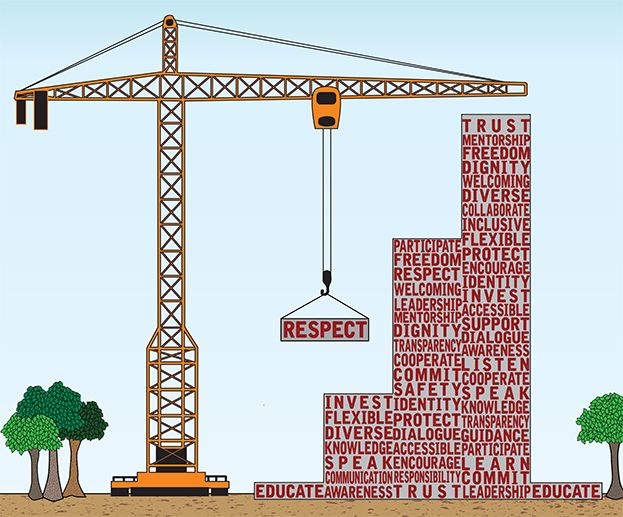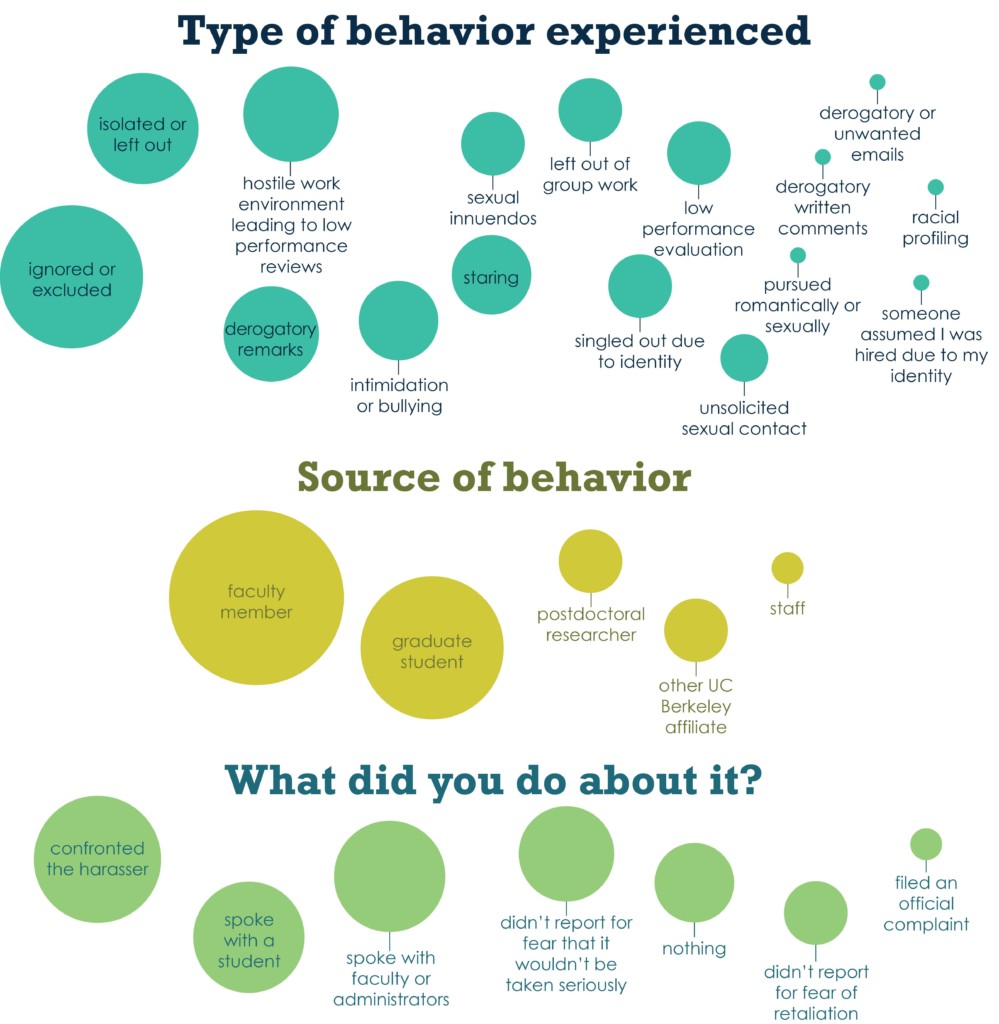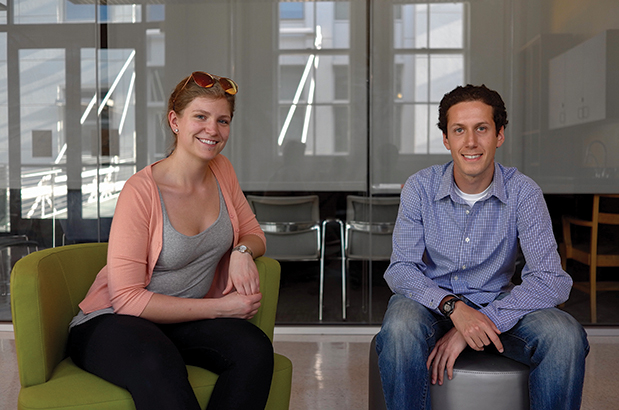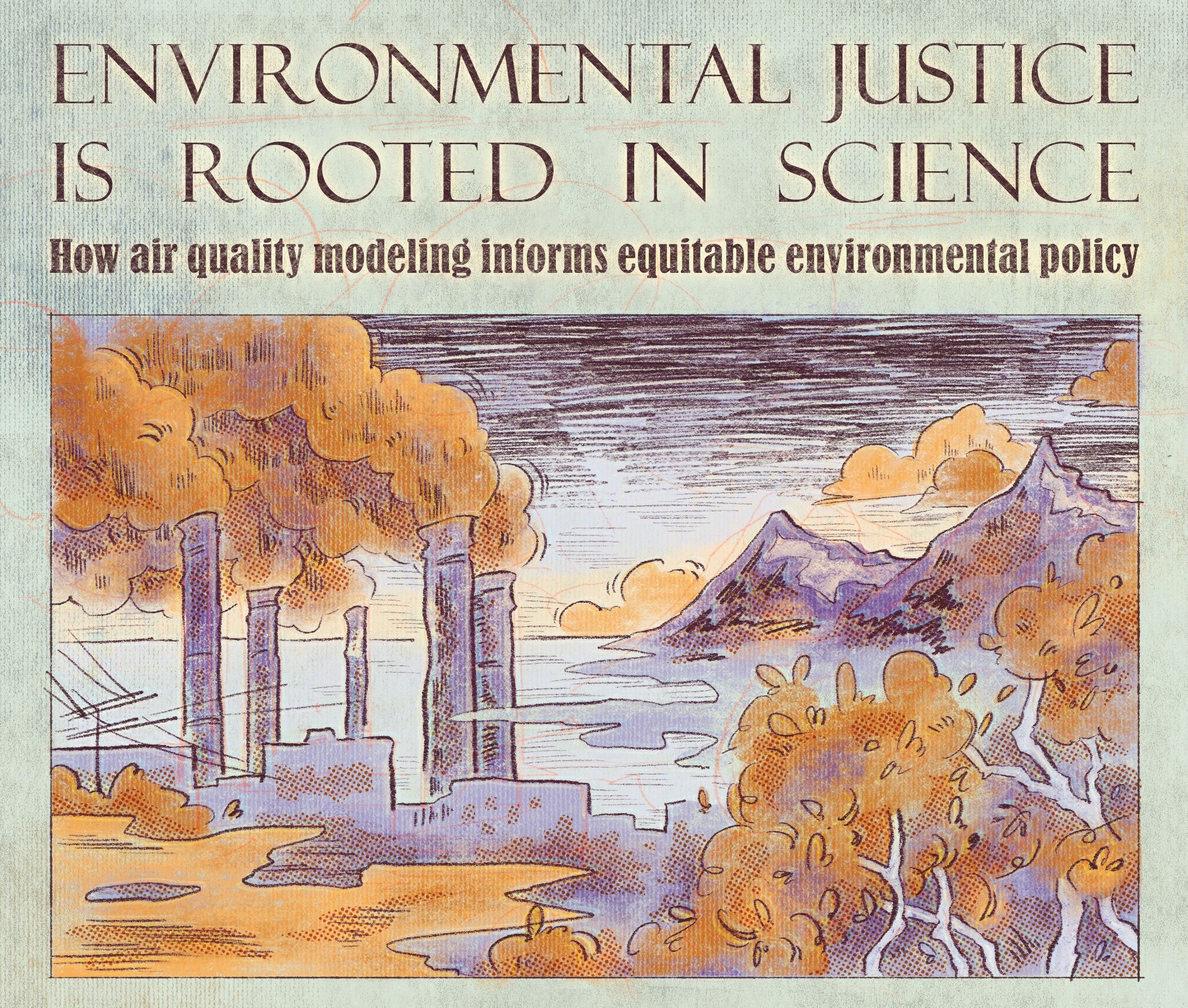Constructing a Respectful Community
By Anna Vlasits, Emily Hartman, and Rachel Hood
November 28, 2016

Rebecca Johnson* stood in front of roughly 100 students, postdocs, and faculty from her department and began to present the results of a survey. Blue bar graphs and percentages flashed up on the projector screen. Occasionally, her voice shook.
The department was having a town hall meeting to discuss the results of a survey of academic climate given to its members in Spring 2016. The patterns revealed by the survey were concerning: almost half of graduate students had experienced some kind of harassing or offensive conduct from faculty, staff, or another graduate student in the past three years.
Across departments at UC Berkeley, indicators of poor academic climate are easy to find. In addition to several recent high-profile sexual harassment cases, departments have experienced low admission and matriculation rates of women and minorities, advisor-advisee tensions, and even suicide. And UC Berkeley is not alone—these issues appear to be affecting academic departments throughout the country.
In the face of this grim status quo, graduate students at UC Berkeley have begun the hard work of improving academic climate. The BSR talked with representatives from eight departments at UC Berkeley and found that in most cases, the first step was to give a climate survey—an attempt to catalogue the issues a given department faces so as to better address them.
This is the story of Johnson’s survey, which was shared with the BSR on the condition that the department and all the people in that department remain anonymous. As a specific case, it reveals what many departments are finding: a climate survey can illuminate the path to building a more respectful and inclusive academic community.
Survey challenges
Johnson is a student in the graduate program and is part of her department’s Climate Committee. That group formed after news broke in 2015 that two prominent UC Berkeley faculty members were involved in sexual harassment cases.
“I think that everyone who got involved [with the committee] was concerned about something. Their friend. Themselves. Their undergraduate student. Whatever it was,” Johnson said.
The Climate Committee’s first action was to administer a survey to take a quantitative pulse of the department. Rather than design a survey from scratch, Johnson and her fellow committee members turned to a professor named Tania Lombrozo, head of the psychology department’s Climate and Equity Committee, who had recently helped administer a climate survey in her own department.
Seeking expert help was a wise decision: research on surveys themselves shows that small changes to questions can bias or alter results. For example, a question like “How often do you experience poor academic climate in your department?” conveys a strong viewpoint and contains an intrinsic assumption. This phrasing will likely produce different results than a more neutral question—such as, “Rate your academic climate from 1 to 5.”
Lombrozo isn’t the original source of the survey Johnson ultimately used. When Lombrozo’s committee decided to administer the psychology department’s survey, a Google search led her to the University of Michigan’s ADVANCE program. This program, founded in 2002, posts surveys online and helps departments across the country conduct climate surveys. The survey includes questions that ask about elements of negative climate, like how racist or homophobic a department feels, and also asks about the specifics of negative incidents people have experienced.
“We draw on standard measures that people have used before. So yes, there’s definitely science involved,” said Janet Malley, the Director of Research and Evaluation at the Michigan ADVANCE program. Their survey was created based on surveys used in sociology and psychology studies, which were validated by experts.
But even when using a survey created by experts, several logistical issues arise when a graduate student tries to administer a survey on an intimate scale. Johnson’s department is on the small side, with low ethnic and gender diversity. Questions that get into personal identity could lead to single students being uniquely identified.
To address this, the Climate Committee made a completely separate survey to collect demographic information. Using that demographic information, the committee knew what the general makeup of the respondents was, but their identities weren’t directly linked to the findings of the climate survey.
Keeping people anonymous can limit the information gleaned from the survey. For example, in Johnson’s survey, students were asked whether they found the department more protective or more threatening. The vast majority of people chose “protective," but two percent of people marked the department as “very threatening." “We don’t know for sure what is causing people to find the environment on the extreme end of threatening,” said Johnson.
It’s an uncomfortable chicken-and-egg problem. Based on the fact that almost half of students in the department experienced climate issues at some point, it’s likely that certain minority groups are treated negatively. But without knowing who feels excluded, the department may just continue to be threatening to those people.
Discussing the results
After the graduate students on the Climate Committee in Johnson’s department crunched the numbers, they held a town hall to discuss the results.
“The way we structured the town hall, it was just … I don’t know if it was by accident, it was so weird,” Johnson said. First, graduate students and postdocs gathered, reviewed the results, and shared their thoughts. Then the faculty arrived.
“So the students were there. We had pizza. We moved to make room for the faculty, but everyone moved from one side of the room to the other, and it was in a circle, so it ended up being the faculty on one side and the students on the other,” Johnson said. “To me, it contributed to this us-versus-them feeling, where we’re sitting, facing each other.”
Then Johnson stood up and presented the results. “I made the deliberate choice to not interpret it too much,” she said.
 44% of graduate students in this department at UC Berkeley have experienced at least one kind of harassing behavior. Students could choose more than one option. credit: Jo Downes Bairzin with data from Rebecca Johnson*
44% of graduate students in this department at UC Berkeley have experienced at least one kind of harassing behavior. Students could choose more than one option. credit: Jo Downes Bairzin with data from Rebecca Johnson*
The faculty were quite surprised, according to Johnson as well as Professor Stevenson*, the head of the graduate program in Johnson’s department. Some of the results were relatively positive—for instance, 61 percent of department members find the department to be inclusive. But when asked whether, in the past three years, they had “personally experienced any exclusionary behavior (e.g., being shunned, ignored), intimidating, offensive, and/or hostile conduct (harassing behavior),” 44 percent of graduate students, 28 percent of postdocs, and 20 percent of faculty responded yes.
So they started talking about it, and even though everyone was—as Johnson put it—respectful, the topic of conversation got a little skewed. “I don’t know how this happened, but somehow people just ended up in the conversation talking a lot more about sexual harassment—because that’s had a lot of media attention,” she said.
“The faculty, some of us felt like we were being surprised by a bunch of these very uncomfortable issues and accusations that we just didn’t know about. And it happened in this us-facing-them format,” Professor Stevenson said. “But I wouldn’t characterize the overall culture of the department as an us-versus-them culture.”
Even when students and faculty aren’t physically separated across a room, town halls can create significant tension within a department. Part of the challenge stems from the uneven power dynamic between faculty and students, even in an inclusive town hall environment. Graduate students rely on the support of faculty to advance their careers, which can make students unwilling to voice their concerns.
Robert Bergman, a professor emeritus of chemistry who was involved in an ad hoc committee on faculty-graduate student mentorship in the chemistry department last year, said that faculty-student dynamics in academia vary widely—some mentors are kind and supportive, while others are less so. “That’s a hard thing to change, and I don’t really know what the solution is other than to talk about it,” he said.
During Johnson’s town hall, “we tried to create time for a dialogue, but it just wasn’t possible,” Johnson said. There were just too many people present, and certain voices, as in many large meetings, dominated the conversation.
Johnson and Professor Stevenson said their department’s next climate event will likely feature a more informal atmosphere, with small group discussions to give everyone a chance to talk. This time around, “I don’t know if people feel like anything was resolved or done,” Johnson said. “Maybe just talking about it is good.”
Subtle little issues
 By the numbers: Grad students, postdocs and faculty rate their department. Source: anonymous climate survey conducted by Johnson and colleagues about their department at UC Berkeley. Credit: Jo Downes Bairzin*
By the numbers: Grad students, postdocs and faculty rate their department. Source: anonymous climate survey conducted by Johnson and colleagues about their department at UC Berkeley. Credit: Jo Downes Bairzin*
At the very least, climate surveys and town hall meetings can reveal the nature of the problems a department faces. And among departments that have conducted climate surveys, a trend has emerged: smaller issues are far more common than explicit cases of harassment, assault, and discrimination. A few people reported sexual harassment or assault in Johnson’s survey, but the majority of cases were, according to Johnson, “more small, everyday issues going on that are causing problems.”
These small issues are often called microaggressions—a term that describes subtle but offensive actions or comments directed at a non-dominant identity group. One example of a microaggression would be if two Asian students were often confused for each other by other members of a department.
Microaggressions are all the more challenging to address because they often don’t rise to the level of an actionable offense. According to a UC Berkeley spokeswoman, Berkeley’s Title IX Office (the Office for the Prevention of Harassment and Discrimination, or OPHD) does receive complaints that don’t rise to the level of violating nondiscrimination policies. But it’s unclear how often students report minor issues. In Johnson’s survey, just 20 percent of students who have experienced a negative incident made a formal report.
Other departments at UC Berkeley have reached similar conclusions. Graduate student Melanie Drake helped run and analyze several department-wide surveys through a student group in her home department, chemical and biomolecular engineering. In 2015, she added a question about microaggressions, asking whether students had experienced a microaggression from faculty members. A significant number of respondents had.
When faculty were presented with the data, the first reaction was confusion about what a microaggression was. So the department hosted a representative from UC Berkeley’s Gender Equity Center to speak about it to them.
This year, the faculty in chemical and biomolecular engineering asked for more specifics. So Drake’s student group added a question in the survey about whether the microaggression occurred based on race, gender or gender identity, physical appearance, or clothing and accessories.
The results showed that microaggressions are happening in many forms. As in Johnson’s department, the perpetrators included members throughout the community surveyed—faculty, graduate students, and undergraduates. In total, 26 percent of the respondents in that department had experienced a microaggression in the past 12 months. However minor each incident may seem, it’s clear that microaggressions are making academia feel unwelcoming for a significant fraction of its members.
These results were presented at a town hall in Drake’s department in Fall 2016. “It was clear that the faculty are equally upset by these microaggressions and genuinely interested in ideas for combatting them,” Drake said.
Professor Stevenson, the head of the graduate program in Johnson’s department, agreed. “Some of it is simply a matter of pointing out to the faculty that ways that we’re used to interacting are not necessarily warm and welcoming for everybody. And I think just bringing that up as a topic of discussion, the faculty can make big changes.”
UC Berkeley, through a new center for survivors of harassment and discrimination called the Path to Care Center, is hoping to provide support for victims of all kinds—including victims of microaggressions. “Even in cases where a comment, behavior, or action doesn’t violate university policies, there are many ways that students, faculty, and staff can intervene and reinforce positive social norms that demonstrate our values and true commitment to inclusion,” a UC Berkeley spokeswoman said.
What to do next
For departments that have conducted climate surveys, it’s not always clear what the next steps should be. Some involved in climate surveys believe just seeing the data might help to make a difference on its own. Unlike university-wide surveys, in which large samples feel removed from an individual’s own behavior, department surveys reveal the local climate department members themselves are creating. They hit close to home.
Drake from chemical and biomolecular engineering thinks many will change their behavior once they see the survey data. “Especially in science departments, everyone is such a data-driven individual already,” she said.
Speaking for the faculty in Johnson’s department, Professor Stevenson said that “the mindset of the students and how they’re feeling about the research environment had been in the past less on our radar. So this [survey] was very useful for bringing those issues up to us.”
 Students in the chemical and biomolecular engineering department at UC Berkeley were asked to list the top three traits they look for in a research mentor. Among the most common answers were good communication, clear expectations, and a focus on mentorship. Word size corresponds to frequency in responses. Credit: Jo Downes Bairzin, created with Tagxedo.com.
Students in the chemical and biomolecular engineering department at UC Berkeley were asked to list the top three traits they look for in a research mentor. Among the most common answers were good communication, clear expectations, and a focus on mentorship. Word size corresponds to frequency in responses. Credit: Jo Downes Bairzin, created with Tagxedo.com.
Others are more cynical about whether seeing the data alone can change behavior. But many departments have made small, relatively straightforward adjustments in light of climate survey results in recent years. For instance, the chemical and biomolecular engineering program is organizing a colloquium to educate faculty and students about microaggressions. The department also started providing written feedback about preliminary exams to all students after they found out that students didn’t know why they’d passed or failed.
Other departments have adjusted stipends when they found out students were stressed by finances, changed the procedure for choosing an advisor when they realized there was pressure to stay in a lab that was a poor fit for the student, or included students on faculty hiring committees when they realized students felt faculty were choosing to hire bad mentors. One department now hosts a counselor in-house several times a week for students to visit.
But in many departments, just creating a low-stakes forum for discussing climate issues is a high priority for students. At Johnson’s town hall, several students expressed the need for a way to report harassment and related problems without automatically triggering official procedures, which some see as a bureaucratic nightmare and possibly career-ending.
“Many, many of the faculty would really like to be a person that a student can go to with any type of problem,” Professor Stevenson said. “We can [offer guidance] for many different problems that the students are having. But we’re not allowed to do that when students report sexual harassment.” Indeed, faculty and staff are required to report any harassment-related incidents involving students that they hear about. In part, this policy is in place to prevent legitimate cases of harassment from being improperly handled and to allow a central office to collect data to inform the creation of university-wide policies.
The sequence of events that ensues when a university member contacts OPHD about an incident includes options for conflict resolution outside of a formal investigation (called early or alternative resolution). This option could be used in certain types of cases, such as a minor incident of unwanted verbal comments. Given the reluctance of students to report minor incidents, it seems that many are unaware of these official channels or feel that the choice would no longer be theirs in how to handle the issue.
Bergman, professor in the chemistry department, is in favor of departments handling many of their own issues. “Departments have a tremendous amount of autonomy,” he said. “Solving things at the department level has a lot to recommend it, because every department has a different culture and every department has different kinds of problems.”
One solution being put in place by Lombrozo’s Climate and Equity Committee in the psychology department is an anonymous online tool to report microaggressions. The committee will review all entries before making them available to the department in a summarized form—no naming names, no formal investigation.
“The point of something like this would be the sort of small everyday things that affect climate … and where you don’t necessarily want to get the person in trouble,” says Lombrozo.
Who should be surveying?
Over and over, the BSR found that graduate students have spearheaded many of the recent department climate survey efforts. But the collective memory of graduate students can fade every few years. This raises the question: should graduate students really be the ones putting on climate surveys?
Cheri Ackerman, a graduate student from chemistry who was on the same mentorship committee as Professor Bergman last year, said, “all of the older professors who I talked to about this issue said, ‘this always goes in cycles.’” Graduate students care about climate for a few years, and then they graduate. When a fresh set of graduate students face a hostile academic climate, the cycle begins again.
Professor Bergman agreed, but doesn’t think the wax and wane of attention on department climate is always a bad thing. “The efforts to make any kind of social change will generate activists who lose hope after a while, and then another bunch of people will try again … and all of a sudden, society responds for reasons not clear to me,” he said. “You have to keep trying. And I think we’ve made some progress.”
There are certainly examples of large-scale, institutional efforts to address academic climate across the country, including at UC Berkeley. The UC system administered a system-wide campus climate survey in 2013 and a survey of Graduate Well-Being in 2015. Earlier this year, the Association of American Universities administered a climate survey to 26 of its member universities. The Michigan ADVANCE program was born from an NSF ADVANCE Institutional Transformation award, which was awarded to over 20 additional universities to address issues with gender balance in academic departments across the country.
But many of these surveys don’t reveal the intimate picture of a specific community’s issues that a department climate survey provides. Michigan’s ADVANCE program, at least, has an advantage over ad hoc surveys conducted by graduate students at other universities: the ADVANCE program itself acts as a clearinghouse for administering surveys and analyzing the survey results within the University of Michigan. This helps address issues with anonymity without losing sight of a specific department’s issues.
UC Berkeley expressed support for graduate student-led efforts on campus to combat negative climate. “We know that working in partnership as a campus community is essential to improving campus climate and creating an environment where everyone feels safe, respected, and welcomed,” a spokeswoman for the university said.
In general, Lombrozo said, she thinks “it would be a really good idea for there to be sort of a larger-scale attempt to do [surveys] across departments and at regular intervals” at UC Berkeley. Institutionalized support for department surveys could help make data collection more regular without losing the benefits of assessing departments individually. And having the ability to compare results from year to year could clarify whether different policies that departments put in place are actually effective.
In Johnson’s department, the faculty are allowing the students to spearhead changing academic climate by design. Professor Stevenson said, “we made the decision that since we, as faculty, don’t really know the full set of issues yet, we wanted to leave the direction of this in the hands of the students—at least to start.” He said department faculty have asked the Climate Committee to create a strategy for keeping the group going once key students like Johnson graduate.
And in situations where it becomes clear from the students that a policy change is needed, Professor Stevenson is ready to take action by changing department policies.
Respect is Part of Research
Just as graduate students at UC Berkeley have taken the lead in conducting climate surveys, they have also been proactive in offering solutions for poor academic climate. Three years ago, physics graduate students Simca Bouma and Sam Kohn created a peer training workshop called Respect is Part of Research (RPR). Their goal was to train incoming graduate students about the intricacies of their new academic role. This August, Johnson’s department tried the workshop out themselves.
 “Simla Bouma and Sam Kohn, organizers of Respect is Part of Research.” Credit: Michael Wan.
“Simla Bouma and Sam Kohn, organizers of Respect is Part of Research.” Credit: Michael Wan.
One of the most notable results of Johnson’s climate survey was that over a third of climate incidents were perpetrated by graduate students themselves. “You’re in this strange intertwining of your social and professional lives that makes it really easy for something that would totally slide when you’re with a few friends at a bar to become hugely uncomfortable in your workplace,” Bouma says. Their hope for the workshop is to “encourage people to think actively about participating in improving the climate.”
In the workshop, the physics students give a lecture about resources and definitions, which was created with advice from OPHD and the Path to Care Center. After that, first-year students break off into groups and have conversations with senior graduate students from their own program who’ve been trained to lead them through case studies. The case studies are real incidents that have been reported to OPHD in the past—changed to protect the identities of the people involved.
Fiona M. Doyle, Dean of the Graduate Division, said in a statement on UC Berkeley’s Graduate Division website, “I’ve been heartened by the involvement of students in education to prevent and respond to sexual violence and harassment.” OPHD and Path to Care support the RPR efforts. Now, the workshop counts as a substitute for the University-wide training that all incoming graduate students have to take, says Kohn.
During orientation this Fall, several Climate Committee members, including Johnson, were trained to lead the RPR workshop, and then did the workshop with the first year graduate students.
One male first year student said that the workshop was a good chance for him to absorb the different kinds of incidents that can happen—things he was unaware of. “And that’s where I come at it, in terms of my privilege to be unaware of those kinds of things happening.”
Another of the first year students in Johnson’s department, Sarah Smith*, was a victim of harassment as an undergraduate at another university. In the open atmosphere of the RPR workshop, she was able to share her experience: she was stalked by a postdoc. “I generally don’t think that you should speak up [as a victim] just because that’s what I’ve seen,” Smith said. “I didn’t know that there were any resources at [my undergraduate institution] that you could do about this sort of thing.”
She said that the best part of the workshop was that she could discuss her discomfort with reporting an incident with senior graduate students and her new classmates. Smith said that if she had only been given a slideshow telling her to report incidents of harassment, “then you’re like, okay, but who actually does that?”
In the workshop, everyone discussed how, in fact, there are confidential ways to report an incident: students can tell their classmates, a counselor, or a Path to Care official about it. The Climate Committee members who were involved with the RPR workshop have volunteered to be available to any of the first years who need someone to talk to.
“It was both useful to have all of the resources put out, and then also this affirmation from fellow students being like ‘yes, you should [report], this is what most people do, this is what your peers are doing,’” Smith said.
Johnson is hopeful that the support network created by the workshop will start the new students off right. “For me, it took a few years of settling into graduate school to feel comfortable speaking up. The problem is that, by then, things can be really hard to change,” she said. “I really wanted to encourage my incoming peers to try to nip these situations in the bud.”
After the training, Smith thinks, if she encounters negative climate in the future, that she’ll be more likely to report it or confront the perpetrating individual than she was as an undergraduate.
Johnson thinks the program was a success.
These names have been changed for the purpose of this article.
Featured image credit: Jo Downes Bairzin.
This article is part of the Fall 2016 issue.



